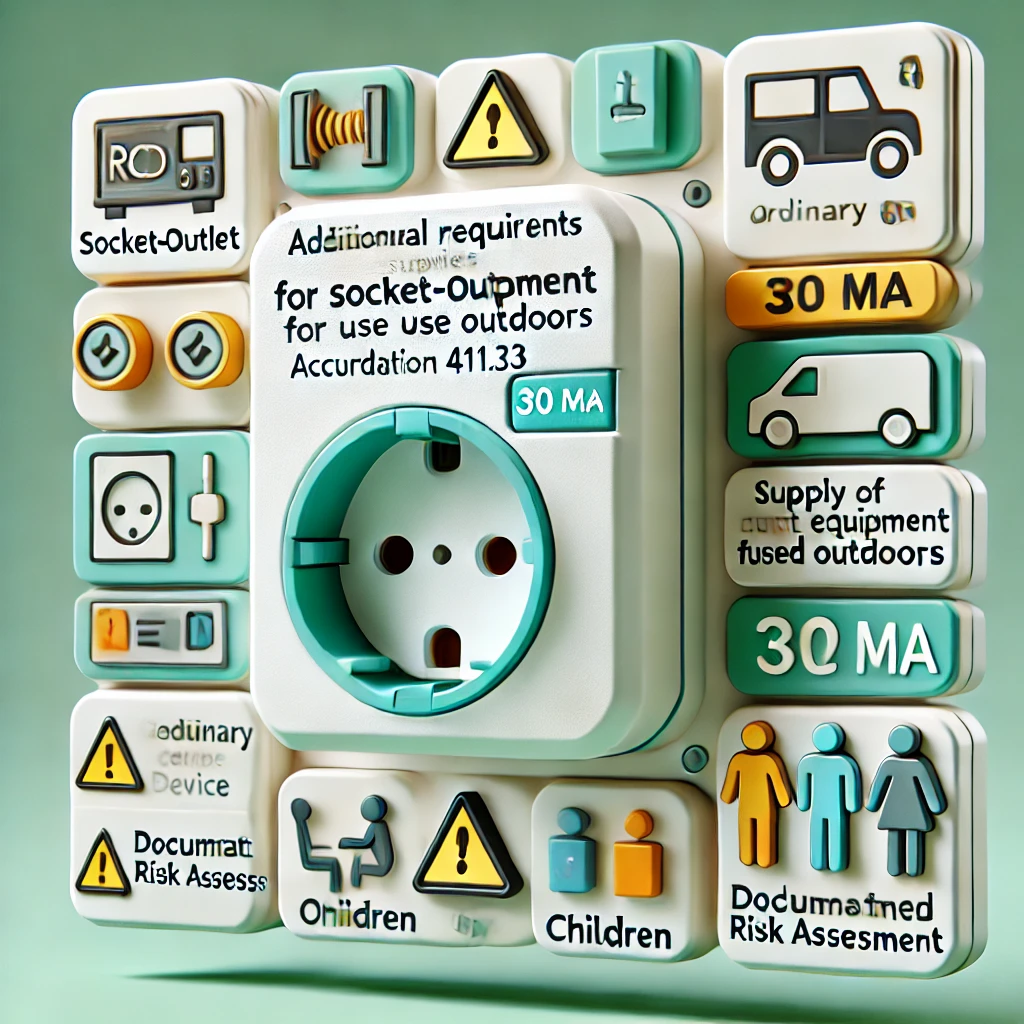What are the additional requirements for socket-outlets and the supply of mobile equipment for use outdoors?
Regulation 411.3.3 states 'In AC systems, additional protection by means of an RCD with a rated residual operating current not exceeding 30 mA shall be provided for (i) socket-outlets with a rated current not exceeding 32 A in locations where they are liable to be used by persons of capability BA1, BA3, or children (BA2, BA3), (ii) socket-outlets with a rated current not exceeding 32 A in other locations, and (iii) mobile equipment with a rated current not exceeding 32 A for use outdoors.'

OW London Electrician and Home Automation Engineers Team
What are the additional requirements for socket-outlets and the supply of mobile equipment for use outdoors?
Regulation 411.3.3 states:
"In AC systems, additional protection by means of an RCD with a rated residual operating current not exceeding 30 mA shall be provided for:
(i) socket-outlets with a rated current not exceeding 32 A in locations where they are liable to be used by persons of capability BA1, BA3, or children (BA2, BA3),
(ii) socket-outlets with a rated current not exceeding 32 A in other locations, and
(iii) mobile equipment with a rated current not exceeding 32 A for use outdoors.
An exception to (ii) but not (i) or (iii) is permitted where a suitably documented risk assessment undertaken with the involvement of a skilled person (electrically) determines that RCD protection is not necessary.
Notes:
For the purpose of this exception, an ordinary person (BA1) instructed in the use of the installation does not become an instructed person (electrically) or cease to be an ordinary person.
The documented risk assessment shall be provided with the appropriate electrical installation certificate.
The requirements of Regulation 411.3.3 do not apply to FELV systems according to Regulation 411.7 or reduced low voltage systems according to Regulation 411.8.
See also Regulations 314.1(iv) and 531.3.2 concerning the avoidance of unwanted tripping.
RCD protection of all socket-outlets is recommended.
See Appendix 2, item 11 in respect of risk assessment.
A lighting distribution unit complying with BS 5733, shaver supply unit complying with BS EN 61558-2-5, luminaire track system, installation coupler, LSC or DCL is not regarded as a socket-outlet for the purposes of this regulation."
To ensure safety, especially in environments where electricity might pose a higher risk, certain additional protections are mandated by Regulation 411.3.3. Here’s a breakdown:
RCD Protection Requirement:
-
Socket-Outlets Up to 32 A:
- If the socket-outlet is in a place where children or other vulnerable people (BA1, BA2, BA3) might use it, an RCD (Residual Current Device) with a sensitivity of 30 mA must protect it.
- This also applies to all socket-outlets up to 32 A in other locations.
-
Mobile Equipment Used Outdoors:
- Any mobile equipment that is used outdoors and operates on a current up to 32 A must also have RCD protection.
Exceptions:
For socket-outlets up to 32 A in locations where they are not used by children or vulnerable people, an RCD might not be necessary if a thorough risk assessment is done by a qualified electrician who determines that the RCD is not needed. This risk assessment must be documented and included with the electrical installation certificate.
Special Cases:
- The regulation does not apply to systems that operate on very low voltages (FELV systems) or reduced low voltage systems, as specified in other parts of the BS 7671 standards.

Frequently Asked Questions
Q: What is an RCD and why is it important?
A: Regulation 411.3.3 defines an RCD as a safety device that quickly breaks an electrical circuit to prevent serious harm from an ongoing electric shock. It is particularly important in preventing electrocution in environments where there is a higher risk of electrical faults, such as outdoors or in places accessible to children.
Q: Who qualifies as a 'skilled person (electrically)'?
A: A skilled person (electrically) is defined in Regulation 411.3.3 as someone who has the technical knowledge or experience to enable them to avoid dangers which electricity may create. This typically means a qualified electrician or someone with equivalent training and expertise.
Q: What is a 'documented risk assessment'?
A: A documented risk assessment, as per Regulation 411.3.3, is a written evaluation of potential risks associated with electrical installations, conducted by a skilled person. This document assesses the need for RCD protection and justifies why it might not be necessary in specific situations.
Q: What does 'BA1', 'BA2', and 'BA3' refer to?
A: Regulation 411.3.3 categorizes people according to their capability:
- BA1: Ordinary persons (those without specific electrical knowledge or experience).
- BA2: Children.
- BA3: Persons with disabilities or certain physical limitations.
Q: Are there any exceptions to the RCD protection requirement for socket-outlets?
A: Regulation 411.3.3 allows exceptions for socket-outlets up to 32 A in locations not used by children or vulnerable people, if a thorough risk assessment by a qualified electrician determines it is not needed. This risk assessment must be documented and included with the electrical installation certificate.
Suggested filename: additional-requirements-for-socket-outlets-and-mobile-equipment-use-outdoors.md
What users Saying
Discover what our customers think about our services. Their feedback reflects our commitment to delivering exceptional service and expert solutions for all electrical and security needs.

